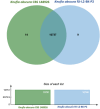Genomic and morphological characterization of Knufia obscura isolated from the Mars 2020 spacecraft assembly facility
- PMID: 38806503
- PMCID: PMC11133487
- DOI: 10.1038/s41598-024-61115-1
Genomic and morphological characterization of Knufia obscura isolated from the Mars 2020 spacecraft assembly facility
Abstract
Members of the family Trichomeriaceae, belonging to the Chaetothyriales order and the Ascomycota phylum, are known for their capability to inhabit hostile environments characterized by extreme temperatures, oligotrophic conditions, drought, or presence of toxic compounds. The genus Knufia encompasses many polyextremophilic species. In this report, the genomic and morphological features of the strain FJI-L2-BK-P2 presented, which was isolated from the Mars 2020 mission spacecraft assembly facility located at the Jet Propulsion Laboratory in Pasadena, California. The identification is based on sequence alignment for marker genes, multi-locus sequence analysis, and whole genome sequence phylogeny. The morphological features were studied using a diverse range of microscopic techniques (bright field, phase contrast, differential interference contrast and scanning electron microscopy). The phylogenetic marker genes of the strain FJI-L2-BK-P2 exhibited highest similarities with type strain of Knufia obscura (CBS 148926T) that was isolated from the gas tank of a car in Italy. To validate the species identity, whole genomes of both strains (FJI-L2-BK-P2 and CBS 148926T) were sequenced, annotated, and strain FJI-L2-BK-P2 was confirmed as K. obscura. The morphological analysis and description of the genomic characteristics of K. obscura FJI-L2-BK-P2 may contribute to refining the taxonomy of Knufia species. Key morphological features are reported in this K. obscura strain, resembling microsclerotia and chlamydospore-like propagules. These features known to be characteristic features in black fungi which could potentially facilitate their adaptation to harsh environments.
Keywords: Chaetothyriales; Extremophile; Trichomeriaceae; Black fungi; Genomics.
© 2024. The Author(s).
Conflict of interest statement
The authors declare no competing interests.
Figures








Similar articles
-
Description and Genome Characterization of Three Novel Fungal Strains Isolated from Mars 2020 Mission-Associated Spacecraft Assembly Facility Surfaces-Recommendations for Two New Genera and One Species.J Fungi (Basel). 2022 Dec 23;9(1):31. doi: 10.3390/jof9010031. J Fungi (Basel). 2022. PMID: 36675851 Free PMC article.
-
Genomic characterization and radiation tolerance of Naganishia kalamii sp. nov. and Cystobasidium onofrii sp. nov. from Mars 2020 mission assembly facilities.IMA Fungus. 2023 Aug 11;14(1):15. doi: 10.1186/s43008-023-00119-4. IMA Fungus. 2023. PMID: 37568226 Free PMC article.
-
Knufia obscura sp. nov. and Knufia victoriae sp. nov., two new species from extreme environments.Int J Syst Evol Microbiol. 2022 Oct;72(10). doi: 10.1099/ijsem.0.005530. Int J Syst Evol Microbiol. 2022. PMID: 36201346
-
Preliminary Planning for Mars Sample Return (MSR) Curation Activities in a Sample Receiving Facility (SRF).Astrobiology. 2022 Jun;22(S1):S57-S80. doi: 10.1089/AST.2021.0105. Epub 2022 May 19. Astrobiology. 2022. PMID: 34904890 Review.
-
[Radiation conditions and radiation risks for cosmonauts flying to Mars using electrical jet microthrusters].Aviakosm Ekolog Med. 2008 Jul-Aug;42(4):55-62. Aviakosm Ekolog Med. 2008. PMID: 19140476 Review. Russian.
Cited by
-
Survival strategies of Rhinocladiella similis in perchlorate-rich Mars like environments.NPJ Microgravity. 2025 May 22;11(1):18. doi: 10.1038/s41526-025-00475-y. NPJ Microgravity. 2025. PMID: 40399358 Free PMC article.
References
MeSH terms
Grants and funding
LinkOut - more resources
Full Text Sources
Miscellaneous

